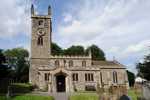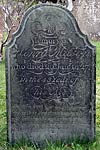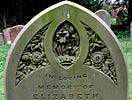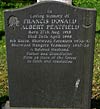 Elston Elston
All Saints
Churchyard
The churchyard surrounds the church and its boundaries are marked by iron railings, a stone wall and a row of trees. The shape is rectangular with the church offset towards the north. There are burials on all sides.
There are no doubt thousands of villagers buried in the churchyard whose headstone or wooden or stone marker have not survived the passage of time, such as John Chappel, mentioned in the Burial Register of 1797 – “John Chappel, labourer, buried November , aged 48 years. He died by the visitation of God in the field as he was returning from his work in the evening of November 1st.” Nor should we overlook those Elston villagers, both adults and children who died in the Southwell Union Workhouse at Upton and who were brought back by horse and cart to be buried anonymously in the churchyard. However, today there are over 400 grave markers including a separate plot on the east side of the church for the cremation ashes of villagers and a separate area for cremated remains. The earliest surviving headstones have been removed from their original position and can be found in a row alongside the church porch. The earliest dates from 1720 and belongs to Anne Foottit who was born in the reign of Charles II. All the grave markers have been photographed and their inscriptions recorded during the past four years and their location plotted.
In 1574 the churchyard was being put to other uses. Adam Arnold of Elston was found guilty in the Archdeanery Court with others “for that they annoye the churchyard by wynowynge corne therein”. They were no doubt providing fodder for their animals.
Since 1610, 11 Rectors of Elston have been buried in the churchyard - the last being the Rev. Frederick Swire in 1886. In Georgian and Victorian times the old rectory stood within the present churchyard and fronted onto Top Street. In the early 1870s it was demolished and the site was consecrated for burial. Surviving evidence of the former rectory is a Georgian gate and railing within the churchyard boundary. At one time this gate led into the rectory garden.
The grave markers take many forms and you will see in some cases that the only evidence of burial is shown by an unmarked cup, vase or bowl, some containing flowers from those who still remember who is buried there.
 Grave marker to Grave marker to
Henry Mason (1827) |
 Detail of grave marker to Detail of grave marker to
Elizabeth Hickman (1889) |
 Epitaph for Epitaph for
John Dobbs (1801) |
 Grave marker to Grave marker to
Francis
Peatfield (1993) |
Some of the fine dark grey headstones appear to be of Swithland slate from Leicestershire which have a fine grained texture. These finely engraved headstones are in part the work of Thomas Wood, a talented monumental mason and sculptor, buried in St Mary’s churchyard in Bingham. His decorative mark showing his name can be found at the base of the headstone. He was born in Bingham in 1760 and died there in 1841. Other skilful masons of this period and whose work is represented in the churchyard include Jones of Bingham, Wallis & Marshall of Newark and Fretwell of Newark.
The church burial registers begin on 12th May 1572 and continue in a near unbroken run to the present day. During 1694 to 1706 and 1783 to 1794 taxes were due on the registration of a burial so many burials went unrecorded. Between 1800 and 1899, 699 burials were recorded.
|